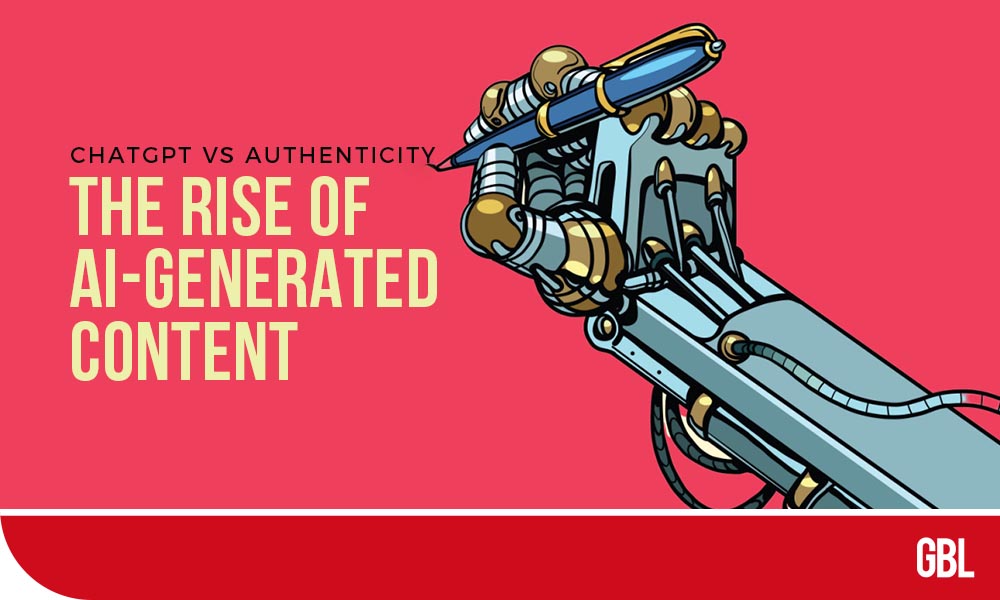Artificial Intelligence (AI) has been advancing at an astonishing pace in recent years. One of the most fascinating and controversial developments is the rise of AI-generated content. AI language models have emerged as powerful tools for various applications, including the following:
- Virtual assistants
- Content generation
- Customer support
ChatGPT, a language model, can generate human-like responses and engage in conversations. While this technological innovation has garnered widespread attention and awe, it has also raised significant concerns regarding authenticity, ethics, and the future of human creativity. Let us see the implications of AI-generated content, delving into the ongoing debate between ChatGPT and authenticity.
The Emergence of AI-Generated Content
The advent of ChatGPT and similar AI models has opened new doors for content creation. ChatGPT has proven its ability to generate remarkably human-like text, enabling it to:
- Mimic conversational styles
- Write articles
- Draft code
- Compose music
This advancement has brought convenience and efficiency to various industries, such as journalism, marketing, and entertainment. However, it also begs the question: at what point does AI-generated content cross the line between convenience and deception?
Quest for Authenticity
Authenticity is a fundamental pillar of human expression and creativity. It is deeply rooted in the uniqueness and personal experiences that individuals bring to their work.
- With AI-generated content, the challenge lies in replicating the authenticity that emerges from human emotions, perspectives, and life experiences.
- While ChatGPT can imitate the style and tone of human authors, it lacks the depth of personal insight and genuine human connection.
The Dark Side of ChatGPT
ChatGPT has faced scrutiny for its potential misuse by malicious actors. There have been concerns about using the model to generate deceptive content, such as deep fakes, fake news articles, or fraudulent messages. This controversy raises questions about the regulation and accountability of AI models to prevent misuse.
Ethical Concerns
The rise of AI-generated content raises ethical concerns. In the realm of journalism, for instance, AI models like ChatGPT can generate news articles at an unprecedented speed. However, the lack of human oversight and critical thinking can disseminate misinformation or biased narratives.
The responsibility for fact-checking and ensuring accuracy falls on the creators and users of AI-generated content, necessitating ethical guidelines and regulations to prevent abuse.
Impact on Human Creativity
AI-generated content has sparked debates about the future of human creativity.
- Some argue that AI models like ChatGPT are tools that can augment human creativity, providing inspiration and assisting in content creation.
- Others fear that the increasing reliance on AI-generated content could stifle human innovation and lead to a world saturated with formulaic, machine-produced works.
Striking a balance between AI assistance and human ingenuity is crucial to preserve the essence of human creativity.
Intellectual Property and Ownership
The question of intellectual property rights becomes complex in the context of AI-generated content. Who owns the content produced by an AI model like ChatGPT? Does it belong to the creator, user, or AI?
Legal frameworks and copyright laws must adapt to address these emerging challenges and ensure appropriate credit and compensation are given for AI-generated works.
Transparency and Accountability
Transparency is vital in the era of AI-generated content. Users should be aware when interacting with an AI system and when content is machine-generated.
- Establishing clear markers or indicators can help maintain transparency and prevent the unintentional spread of AI-generated content as human-authored work.
- Additionally, holding developers and organizations accountable for the actions and consequences of AI models like ChatGPT is crucial to building trust and mitigating potential harm.
Redefining Human Roles
The rise of AI-generated content prompts us to reconsider the roles of humans in various industries. While some fear that AI will replace human workers, others argue that it will allow individuals to focus on more creative and strategic tasks.
- Embracing AI as a tool rather than a replacement can lead to a collaborative environment where humans and machines work together to achieve greater productivity and innovation.
- Investing in upskilling and reskilling programs is essential to ensure that humans can adapt to the changing landscape and find new avenues to contribute their unique skills and perspectives.
Preserving Human Connection
Authenticity goes beyond the content; it encompasses the human connection forged through storytelling, art, and communication. While AI-generated content can mimic human interactions to a certain extent, it lacks the genuine emotions, empathy, and understanding that are inherent in human experiences.
Maintaining and cherishing human-to-human connections in creative endeavors becomes even more crucial in a world increasingly shaped by AI-generated content.
Striking a Balance
Finding the balance between the capabilities of AI-generated content and preserving authenticity is crucial. Rather than perceiving AI as a threat, it can be seen as a tool to enhance human creativity and enable new forms of expression.
By leveraging the strengths of AI, such as its ability to process vast amounts of data and generate ideas, humans can harness its power to amplify their creative pursuits while infusing their unique perspectives and insights.
The Future of AI-Generated Content
As AI technology advances, the potential for AI-generated content will expand even further. Developing more sophisticated language models like ChatGPT will require ongoing discussions and collaborations between AI developers, content creators, policymakers, and society.
Ethical frameworks, guidelines, and responsible practices must be established to navigate the evolving landscape of AI-generated content. It ensures that it serves as a force for positive impact rather than a threat to authenticity and human creativity.
Conclusion
The rise of AI-generated content, epitomized by ChatGPT, presents a fascinating and controversial development in the realms of creativity, authenticity, and human connection. While the capabilities of AI models like ChatGPT are remarkable, the quest for authenticity and the ethical considerations surrounding AI-generated content cannot be overlooked.
By embracing AI as a tool and finding the right balance between AI assistance and human creativity, we can navigate this evolving landscape while preserving the essence of human expression and fostering meaningful connections. The future of AI-generated content lies in our ability to shape it responsibly, ethically, and in harmony with our values as a society.









